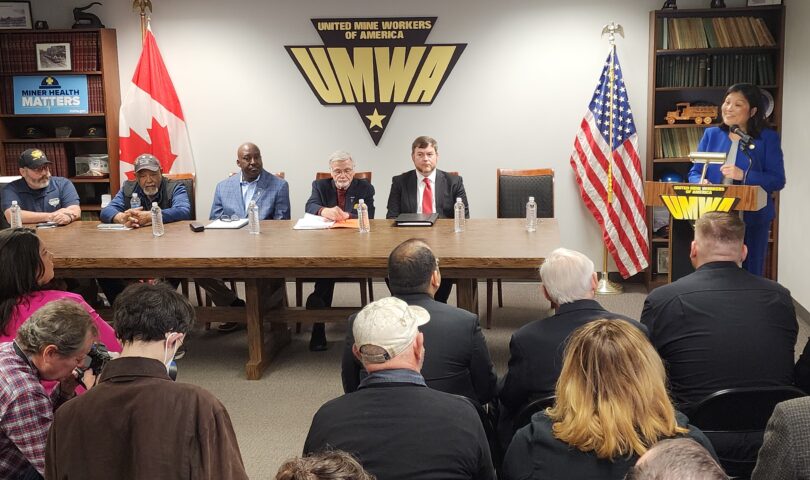UNIONTOWN — Miners and mining labor leaders gathered with U.S. Department of Labor Acting Secretary Julie Su on Tuesday to celebrate DOL’s final rule to protect miners from silica dust.
“Today we’re making it clear that no job should be a death sentence, that every single worker should come home healthy and safe at the end of the day and at the end of a career,” Su told the crowd gathered at the United Mine Workers of America Region 1-District 2 headquarters.
DOL’s Mine Safety and Health Administration proposed the rule last June. MSHA’s current standard for metal/nonmetal (MNM) mines is 100 micrograms per cubic meter of air for a full-shift exposure — meaning an eight-hour time weighted average. For coal mines, there is no separate standard for silica dust.
MSHA’s new standard would match the Occupational Safety and Health Administration standard adopted in 2016: for both MNM and coal mines, 50 micrograms per cubic meter for a full-shift exposure. If a miner’s exposure exceeds the limit, the final rule requires mine operators to take immediate corrective actions to come into compliance.
The rule also establishes an action level matching OSHA’s: 25 micrograms per cubic meter across a full shift. When miners’ exposures is above the proposed action level but below the permitted exposure limit of 50 micrograms, the proposed rule would require mine operators to conduct periodic sampling until miners’ exposures are below the action level.
The proposed rule also includes medical surveillance requirements for MNM miners, modeled on existing medical surveillance requirements for coal miners, and requiring companies to establish medical surveillance programs to provide periodic health examinations at no cost to miners.
Su said it is estimated that in central Appalachia, 1 in 5 long-tenured coal miners have black lung disease, seeing their life expectancy cut by 12 years. MSHA estimates the rule will save more than 1,000 lives and prevent severe illnesses in thousands more.
The rule, she said, will take effect for coal mines in April 2025 and for MNM mines in April 2026, in order to ensure operators have the tools to implement it correctly. MSHA has hired 270 inspectors to replace its depleted numbers and get them out into the field to enforce the rule.
Assistant Secretary for Mine Safety and Health Chris Williamson — who told those gathered that he worked in Morgantown for seven years — said operators must keep their silica dust at the mandated level or lower. “There will be consequences for noncompliance.”
Those include citations, penalties, mandated immediate corrective actions and potential withdrawal orders to suspend operations if the operator fails to abate. MSHA is asking miners to report cheating.
MSHA stands prepared to work with everyone to successfully implement the new rule, he said, and will offer compliance assistance.
“Silicosis and black lung disease are debilitating and deadly, but they are also entirely preventable,” he said. “We should all be able to agree that they should and can become relics of the past.”
Dave Dayton is the Mine Safety Committee chair at the Marion County Mine. He said, “This rule, to be honest with you, is long overdue. It’s something the mining industry has needed for years.”
And Gary Hairston, president of the Black Lung Association, said, “We’ve been fighting for years.”
He has black lung and has suffered with it for a long time. “I was 48 years old when I had to come out of the coal mines,” he said. “If you don’t know how that feels, that you can’t take care of your family.”
He thanked the UMWA for its work to get this rule in place. He told the audience how digging up flowers used to take him 30 minutes and now it takes four hours as he struggles for breath. “I don’t want to see nobody in this kind of shape.”
Dr. David Weissman, director of NIOSH’s Division of Respiratory Disease Studies in Morgantown, talked about the “terrible human cost” of black lung. The new rule will provide miners protections similar to those that already exist for workers in other industries, he said.
“The mining industry is really critical to our nation — it’s an engine of prosperity for many,” he said. “This rule will be good for miners; it will be good for the mining industry, too.”
UMWA President Cecil Roberts closed the ceremony, describing the decades-long fight to achieve this rule. For years and years, the industry denied black lung existed, and doctors supported those claims.
“What does this rule do?” he asked. “It’s not overly complicated. More people will be alive 10 years from now that there would have been if it wasn’t for what we’ve done fighting for this rule. We were on the right side of this. We were doing the Lord’s work here.”
He expects industry push-back, with companies saying they’re trying to shut the industry down. “No, we’re trying to save people’s lives.”
An MSHA fact sheet explains that respirable crystalline silica (silica dust) is an occupational carcinogen that puts workers at risk for developing preventable, severe diseases including silicosis; non-malignant respiratory diseases (e.g., emphysema and chronic bronchitis); lung cancer; and kidney disease. Exposure to mixed coal mine dust containing silica dust can lead to the development of coal workers’ pneumoconiosis (black lung), progressive massive fibrosis, and multi-dust pneumoconiosis.
“Each of these illnesses is chronic, irreversible, and potentially disabling or fatal,” MSHA says.
EMAIL: dbeard@dominionpost.com
TWEET @DominionPostWV




